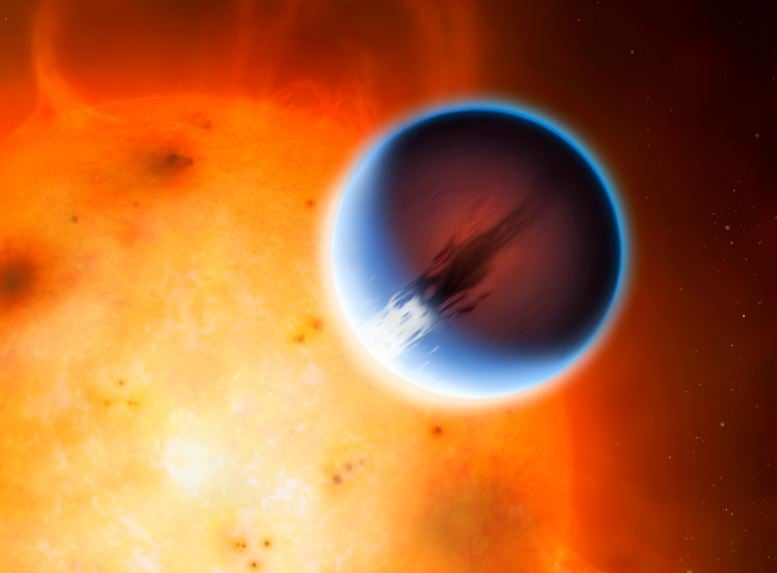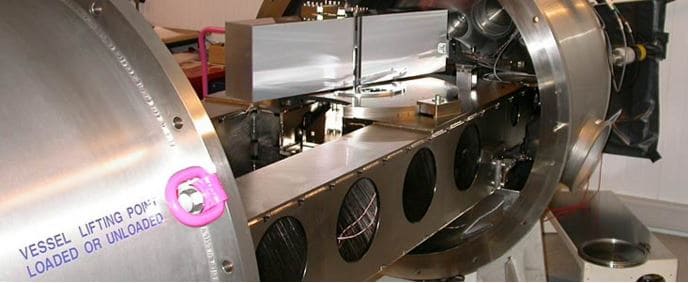Scientists have discovered an exoplanet with 5400 winds and a surface temperature of 1200 °C about 63 light years from Earth. A team from the University of Warwick in England says the exoplanet, called HD 189733b, is the first to have its weather system directly measured and mapped.
Exoplanets, also known as extrasolar planets, are planets outside our Solar System that orbit their own star.
Wind blows on the surface of HD 189733b at seven times the speed of sound, or twenty times anything that has been recorded on Earth, said Tom Louden and Peter J. Wheatley, who both work at the University of Warwick’s Astrophysics Group.
 HD 189733b has ultra-fast winds, a roasting-hot surface, and a bright blue day side. (Image: University of Warwick)
HD 189733b has ultra-fast winds, a roasting-hot surface, and a bright blue day side. (Image: University of Warwick)
Mr. Louden, a PhD student, said regarding the discovery and winds travelling at 2km per second:
“This is the first ever weather map from outside of our solar system. Whilst we have previously known of wind on exoplanets, we have never before been able to directly measure and map a weather system.”
The astrophysicists measured the wind speeds on both sides of HD 189733b. They detected a 5400 mph (8690 kph) wind travelling from its day to night side.
Mr. Louden said:
“HD 189733b’s velocity was measured using high resolution spectroscopy of the Sodium absorption featured in its atmosphere. As parts of HD 189733b’s atmosphere move towards or away from the Earth the Doppler effect changes the wavelength of this feature, which allows the velocity to be measured.”
Measuring the exoplanet’s wind speed
The surface of the star is brighter at its centre than it is on its edges. As the exoplanet moves in front of it, the amount of light blocked by varying parts of its atmosphere changes.
The researchers used this data for the first time to measure the speeds on opposite sides of HD 189733b independently, from which they got their velocity map.
 As the exoplanet moved in front of its star, the scientists were able to directly measure and map its weather system. (Image: University of Warwick)
As the exoplanet moved in front of its star, the scientists were able to directly measure and map its weather system. (Image: University of Warwick)
Dr. Wheatley believes their technique could help scientists who are studying Earth-like planets in their search for extraterrestrial life forms.
Dr. Wheatley said regarding the technique to map weather systems in faraway planets:
“We are tremendously excited to have found a way to map weather systems on distant planets. As we develop the technique further we will be able to study wind flows in increasing detail and make weather maps of smaller planets.”
“Ultimately this technique will allow us to image the weather systems on Earth-like planets.”
Studying ‘Hot Jupiters’
‘Hot Jupiters’, also known as ‘Roaster Planets’, are a class of exoplanets whose features are similar to those of Jupiter, but have very high surface temperatures and orbit super-close to their stars. These types of exoplanets are very popular targets for scientific study.
HD 189733b is a ‘Hot Jupiter’ – it is slightly more than 10% bigger than Jupiter, but 180 nearer its star than Jupiter is to the Sun, and it has a surface temperature of about 1200 °C.
HD 189733b’s size and proximity (astronomically speaking) to our Solar System make it a very popular target for astrophysicists and astronomers to study.
According to prior studies, HD 189733b’s day side would be a light shade of blue to the human eye. The colour is probably due to silicate particles forming clouds high up in its atmosphere.
 The researchers used data from the High Accuracy Radial Velocity Planet Searcher (HARPS). (Image: ESO)
The researchers used data from the High Accuracy Radial Velocity Planet Searcher (HARPS). (Image: ESO)
Mr. Louden and Dr. Wheatley collected and analyzed data from the High Accuracy Radial Velocity Planet Searcher (HARPS), a high-precision echelle spectrograph the ESO (European Southern Observatory) installed in 2002 at La Silla Observatory in Chile. During its active lifetime, HARPS has discovered more than 130 exoplanets.
Reference: “Spatially resolved eastward winds and rotation of HD189733b,” Peter J. Wheatley and Tom Louden. Cornell University Library. Submitted on Nov 11, 2015. arXiv:1511.03689 [astro-ph.EP].
